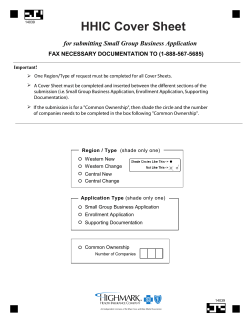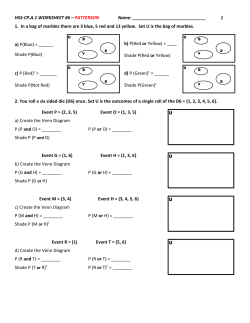
Groundcovers - Department of Horticultural Sciences
Groundcovers Plant List 5 HORT 308/609 Spring 2015 Groundcovers • Many vines also serve as groundcovers – Evergreen versus deciduous – Woody versus herbaceous • Temporary versus permanent – Annual A l versus nurse plants l t All text and images, unless otherwise specified, are copyrighted by: Dr. Michael A. Arnold, Texas A&M University, Dept. Horticultural Sciences, College Station, TX 77843 77843--2133 Ajuga reptans Bugleweed • Evergreen herbaceous groundcover, z. 4 - 8(9) • Stoloniferous rosettes, 2” to 6” tall • Dark green, variegated, purple, pink, red, white ‘Mahogany’ Pachysandra terminalis Japanese Pachysandra • • • • • • Popular rhizomatous low groundcover, popular in USDA hardiness zones 5 (4) - 8 (9a) Uniform dark glossy medium coarse evergreen foliage, also some variegated cultivars Needs shade in south, ok sun or shade in cooler north; insignificant greenish white flowers Needs steady moisture supply, good fertility No foot traffic (Uncle Jim’s Jim s frustration) frustration), chlorosis on high pH soils, tends to establish slowly; not drought tolerant Good companion groundcover to small shrubs as it does not overwhelm them Drought stress • Speed of establishment • Weed suppression • Rapidity of canopy closure • Decreasing spacing is exponential in number of plants & cost required ‘Mint Chip’ Ajuga reptans Bugleweed • Morning sun to dayday-long shade here, full sun in north • Best in moist acidic soils, but tolerates other soils • Fungal crown rot in humid or wet areas, areas but it can be invasive in favorable sites; needs moist soils • Good weed suppression, but intolerant of foot traffic • Blue flowers can be + or – ; deadheading recommended • Often short short--lived in Texas and the Deep South Ardisia japonica Japanese Ardisia • MediumMedium-coarse textured slowly spreading rhizomatous semi--woody evergreen semi groundcover • Handsome dark glossy green leaves • Contrasting red fruit from late fall to winter • Good substitute for Pachysandra in z. 9 (8b) - 13 • Morning sun to moderate shade, some irrigation needed, mulch until canopy closes • Cold damage, algal leaf spot, crown gall, root knot nematodes, and hemispheric scale are occasional problems Ligularia spp. (Farfugium spp.) spp.) Ligularia Ligularia spp. (Farfugium spp spp.) .) Ligularia ‘Aureo-Maculata’ • Evergreen or dieback herbaceous p perennial 1’ - 2’ mounds with flowers 3’ - 4’ • Useful in USDA z. 5(4) - 9(10) – Bold coarse textured leaves – Dark glossy green or splotched • Corymbose, paniculate, or spike--like 3’ to 6’ tall spike inflorescences of yellow composite flowers Asparagus densiflorus ‘Sprengeri’ Sprengeri’ Asparagus Fern • Spreading/sprawling mound of arching stiffly vinevine-like branches, 2’ to 3’ tall • Fine textured bright to dark green leaves • Sparse S tiny ti white hit flowers fl then th red d berries b i Vinca major Big Periwinkle • Essentially a larger version of V. minor • Coarser textured, but more vigorous than V. minor;; can become aggressive; avoid hot dry minor locations, particularly with variegated cultivars • Variegated taxa increasingly popular in the trade • Cold tolerant only to z. 7, but heat tolerant to z. 10 ‘Aureo-Maculata’ • Adapted to shade in south, sun to shade in north • Taxa vary in environmental tolerances, but all need a steady water supply • Alternative to Hosta as a shade groundcover • Deserves wider trialing in our region ‘The Rocket’ Asparagus densiflorus ‘Sprengeri’ Asparagus Fern • Foliage may yellow / brown in response to excess sun, cold, or nutrient deficiencies • Root hardy z. 9 (8b) - 13; f li foliage damaged d d by b hard h d frosts / light freezes • Small scale shade to filtered sun groundcover, hanging baskets, patio containers, weeping over a wall, interiorscapes • Bit spiny on older plants Vinca minor Periwinkle • Attractive evergreen mat mat--forming groundcover • Use mostly in shady locations in TX; can be invasive • 1” diameter blue flowers in spring, sporadically th thereafter; ft adapted d t d tto USDA z.5 5 (4b) – 8a 8 (8b) Aspidistra elatior Cast Iron Plant • Rhizomatous evergreen groundcover, USDA zones 8 (7b) - 13; bold statement • Coarse textured large leaves; tropical effect; contrast to fine textured plants • Fades / burn in sun, very shade tolerant • Well drained organic soil, pH adaptable, moderate heat and drought tolerance • Groundcover, containers, raised beds, good under trees, interiorscapes • Slow to cover ground, limited cold hardiness, insect problems in interiors, Sun scorch periodic cleanclean-up pruning required Nephrolepis exaltata Boston Fern • Spreading clumps of overall sword sword-shaped bipinnately lobed fronds • Legendary interiorscape plant, but a bit messy (drops fronds) • Semi Semi--evergreen (USDA z. 9 - 8b) to evergreen (USDA z. 10 - 13) groundcover; niches in walls or palm trunks; pots & hanging baskets • Most rapid growth in partial shade and fertile moist soils • Low relative humidity or drought induces marginal necrosis Tradescantia pallida Setcreasea • Succulent evergreen purple or green medium medium--coarse groundcover, USDA z. 9(8b) 9(8b)--13 • Small 33-petal pinkpink-purple flowers • Best color in full sun, root rots in wet soils, some irregularity in canopy density • Containers, hanging baskets, groundcover, over low walls Cyrtomium falcatum Holly Fern • Well adapted fern for general use in Texas, USDA z. 8b (8a)(8a)-13 • Fronds reminiscent of holly Fiddlehead leaves, dark lustrous green, sharply serrated margins appear spiny, but are not • Reproduces via sporangia on the backs of the fronds • Needs shade as do most ferns in Texas, best in a moist well drained acidic soil, but can Sporangia tolerate higher pH soils & more salinity than most ferns Thelypteris kunthii Wood Fern • Dieback to semisemi-evergreen herbaceous perennial fern, 2’ to 3’ tall, indefinite spread • Shield Shield--shaped fronds; TX native • Shady moist environments, USDA z. z 8 - 13, 13 better adapted to our region than most ferns • Effective shade groundcover, naturalizing plant; tough fern Ophiopogon japonicus Monkeygrass • Tufted matmat-forming groundcover, more turfgrass turfgrass--like texture than Liriope muscari • Softer texture and lower growing, 2” to 8” (12”) tall, plants than L. muscari • Very useful due to fine texture & shade tolerance, avoid afternoon sun, useful in USDA zones 7 (6b) - 13 Liriope muscari Liriope muscari Liriope Liriope – Dense clumping groundcover once established – Versatile USDA z. 6 - 13 plant; handles full sun p p g japonicus japonicus, j p , conditions better than Ophiopogon – Often thicker coarser foliage than O. japonicus • Flower above or below foliage, neutral to positive feature, purple purple-blue spikes • Variegated forms may tolerate less sun ‘Majestic’ ‘Variegata Variegata’’ Trachelospermum asiaticum Asian Jasmine Trachelospermum asiaticum Winter damage • Woody evergreen groundcover/vine in USDA z. 8 8-13, can be used as herbaceous groundcover z. 7 • Premier groundcover for southern half of Texas • Tolerates full sun to dense shade,, soil adaptable, p , moderately drought & salt tolerant; seldom climbs Asian Jasmine • Good weed suppression once established • Probably overover-used, but hard to beat in adverse sites; variegated cultivars less vigorous • Flowers not as effective, use Trachelospermum jasminoides (Confederate Jasmine) for fragrant white flowers or as a climbing vine in z. 9 (8)(8)-13 Hedera helix Trachelopsermum asiaticum Euonymus fortunei Wintercreeper Euonymus • Extremely variable growth form = vine, groundcover, or small shrub • Useful in USDA hardiness z. 6 (5) - 8 (9a), but needs afternoon shade in T Texas for f best b t performance f • Naturalized, invasive?, in some regions; climbs but slow to start Trachelospermum jasminoides Euonymus fortunei Wintercreeper Euonymus • Often used as groundcover for purple effect in winter or for variegated foliage • Best reserved for use in Central to North Texas • Scale insects, crown gall, anthracnose, aphids Up a tree ‘Coloratus’ Coloratus’ in winter Lonicera japonica Japanese Honeysuckle ‘Purpurea Purpurea’’ • Rampant naturalized vine or groundcover, USDA z. 4 - 9 • Evergreen to semisemi-evergreen • White & yellow spring flowers • Can be major weed problem • Overwhelms smaller plants ‘Halliana Halliana’’ Sphagneticola trilobata Wedelia • Evergreen herbaceous perennial vining groundcover, z. 9 9--13, 6”6”12” (24”) thick • Sparsely distributed yellow daisydaisy-like flowers, contrast with dark glossy green leaves • Rapid grower, sun to part shade, heat & very salt tolerant • Genus = Complaya Complaya,, Sphagneticola, Sphagneticola, Silphium,, Thelechitonia Silphium Thelechitonia,, Wedelia Wedelia? ? Fragaria × ananassa Strawberry Aptenia cordifolia Hearts Hearts--AndAnd-Flowers Aizolaceae • Rich Ri h glossy l succulent l t foliage f li with ith small red compositecomposite-like flowers • Sun to mostly sunny sites, well drained soils; pH adaptable; some salinity and drought tolerance • Limited cold tolerance, useful USDA z. 9(8b) – 13 • Groundcover, roadside plantings, hanging baskets, spiller in patio containers or over low walls F. virginiana Fragaria × ananassa Strawberry Fe chlorosis • Rosette forming stoloniferous herbaceous perennial that spreads to form a mat mat--like groundcover 6” to 8” (10”) tall • Pubescent dark green leaves, ¾” to 1¼” white to pink flowers, & Fragaria × ananassa edible strawberries • June June--bearing versus everbearing • Hardy in z. 5 to 8a, best treated as a cool season annual in 8b - 11 • Avoid heavy clay, high pH soils, or saline soils / irrigation water • Virus, nematodes, animals and Fragaria ‘Pink Panda’ pillbugs can be problems Rubus spp. Blackberries, Raspberries, Dewberries, & Brambles • More often encountered as edible crops • Sometimes effective for dual edible / ornamental purposes • Numerous production practices from low to high tech Primocanes versus floricanes • Usually better in northern portions of our region • Tendency to trap trash • Bank covers, naturalizing, woodland edges, wildscaping,, educational wildscaping gardens, home orchards Trash trap Rubus trivialis Southern Dewberry • SemiSemi-evergreen semisemi-woody vine vine--like suckering bramble groundcover – Handsome dark green lustrous trifoliate leaves and white flowers in spring – Tattered ragged appearance by late summer through winter, spider mites and rust fungus on summer leaves – Hardy in USDA zones 6 – 9 (10) • Valued for edible dewberries of variable quality • Forms dense impenetrable low stands of prickly canes • Too vigorous for mixed plantings Materials presented herein are copyrighted as indicated or by Michael A. Arnold; for permission to use or reproduce these images, please write: Dr. Michael A. Arnold Dept. of Horticultural Sciences Texas A&M University College Station, TX 77843 77843--2133 email ma ma--arnold@tamu.edu Additional images may be viewed on Plant Picture Pages on http://landscapeplants.tamu.edu
© Copyright 2025









